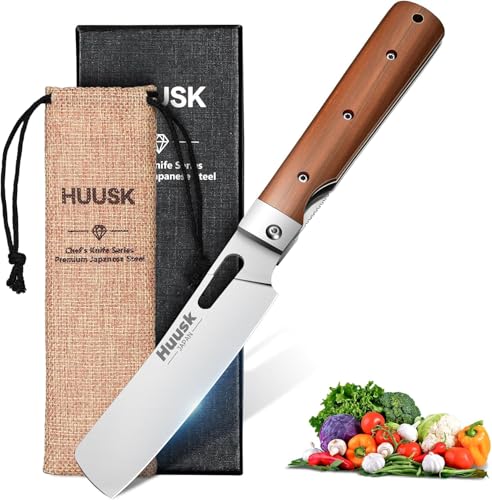Ever find yourself staring at a mountain of vegetables, wishing for a tool that makes chopping a breeze? The Nakiri knife might just be your kitchen superhero. But with so many shapes, sizes, and brands, picking the perfect one can feel like navigating a culinary maze. It’s easy to get overwhelmed by terms like “blade thickness” and “handle material,” leaving you wondering if you’re choosing the right knife for your needs.
This guide cuts through the confusion. We’ll explore what makes a Nakiri knife special and how it can transform your vegetable prep. You’ll learn what to look for in a good Nakiri, from its sharp edge to its comfortable grip. By the end, you’ll feel confident choosing a Nakiri that will make dicing, slicing, and mincing a joy, not a chore.
Our Top 5 Nakiri Knife Recommendations at a Glance
Top 5 Nakiri Knife Detailed Reviews
1. PAUDIN Nakiri Knife – 7″ Razor Sharp Meat Cleaver and Vegetable Kitchen Knife
Rating: 9.0/10
Meet the PAUDIN Nakiri Knife, a 7-inch powerhouse designed to make your kitchen tasks a breeze. This knife is your go-to for slicing, dicing, chopping, and mincing all sorts of ingredients. Its high carbon stainless steel blade promises sharpness and durability, while the ergonomic handle ensures a comfortable and secure grip. Whether you’re a seasoned chef or just starting out, this multipurpose Asian chef knife is a fantastic addition to any home kitchen.
What We Like:
- It’s an all-purpose knife, handling many kitchen jobs.
- The blade is ultra-sharp, cutting through food easily.
- The ergonomic handle feels comfortable in your hand.
- The wave pattern looks beautiful and helps prevent food from sticking.
- It comes in elegant packaging, making it a great gift idea.
- The knife is easy to re-sharpen and maintain.
What Could Be Improved:
- The description mentions “not real Damascus,” which might be a bit confusing for some buyers.
- While durable, it’s always good to be mindful of proper knife care to keep it in top shape.
This PAUDIN Nakiri Knife offers a great blend of functionality and style. It’s a reliable tool that will quickly become your favorite in the kitchen.
2. HOSHANHO 7 Inch Nakiri Knife
Rating: 8.9/10
Meet the HOSHANHO 7 Inch Nakiri Knife, a Japanese-style chef’s knife designed to make your kitchen tasks a breeze. Its sharp blade and comfortable handle make it a joy to use for all your chopping, slicing, and dicing needs.
What We Like:
- Ultra Sharp Blade: The hand-polished 15-degree edge angle makes every cut smooth and effortless. You can perform delicate tasks or powerful chopping with ease.
- Top Grade Steel: Made from Japanese 10Cr15CoMoV high carbon stainless steel, this knife is super hard (60HRC) and stays sharp even with lots of use. It looks new for a long time.
- Ergonomic Handle: The pakkawood handle fits your hand naturally, balancing the knife well and preventing fatigue during long cooking sessions. It feels comfortable to hold.
- Exquisite Design: The cool scallop-shaped hollows on the side not only look good but also help prevent food from sticking. The natural wood grain on the handle adds a touch of style to your kitchen.
- Multi-functionality: This knife is a true all-rounder. It handles vegetables, meat, and fruits with skill, letting you chop, slice, and dice whatever you need.
What Could Be Improved:
- While the pakkawood handle offers a great grip, some users might prefer a different material for a slightly different feel or aesthetic.
- The knife’s sharpness is excellent, but like all high-carbon steel knives, it will require proper care and occasional sharpening to maintain its peak performance over many years.
This HOSHANHO Nakiri knife is a fantastic addition to any kitchen, offering both style and superior performance. It’s a tool that makes cooking more enjoyable and efficient.
3. Huusk Japanese Folding Nakiri Knife – Pocket Chef Knife with 440C Stainless Steel Ultra Sharp Blade
Rating: 8.8/10
Meet the Huusk Japanese Folding Nakiri Knife, your new go-to for precise chopping, whether you’re in the kitchen or out on an adventure. This portable chef knife packs a serious punch with its ultra-sharp blade, making it ideal for everything from dicing onions to slicing fruit.
What We Like:
- The 440C stainless steel blade is super sharp and built to last, perfect for straight-up chopping.
- Its folding design makes it easy to carry anywhere, from your backyard BBQ to a camping trip.
- Each knife is handcrafted through a detailed 138-step process, ensuring top quality.
- The beautiful Cocobolo wood handle feels great in your hand and even gives off a light, pleasant scent.
- It’s incredibly versatile, slicing through vegetables, fruits, and even meat with ease.
- The liner lock keeps the blade securely in place, protecting your fingers.
- Huusk offers a 12-month warranty and 30-day returns, so you can buy with confidence.
What Could Be Improved:
- While designed for portability, some users might prefer a slightly larger handle for extended use.
- The premium materials and handmade craftsmanship mean this knife comes at a higher price point.
This Huusk Nakiri knife blends traditional craftsmanship with modern convenience, making it a fantastic tool and a thoughtful gift. It’s a reliable companion for any culinary task, big or small.
4. Shun Classic Blonde 6.5″ Nakiri Knife
Rating: 8.8/10
Meet the Shun Classic Blonde 6.5″ Nakiri Knife, a handcrafted Japanese vegetable knife that brings precision and ease to your kitchen. This knife is designed specifically for slicing and dicing vegetables, making it a valuable tool for both professional chefs and home cooks. It’s part of Shun’s original and authentic Japanese cutlery line, showcasing pioneering excellence and innovative design.
What We Like:
- It’s a specialized vegetable knife, perfect for slicing and dicing.
- It offers superior sharpness thanks to VG-MAX steel and 68 layers of Damascus cladding.
- The 16-degree edge provides long-lasting performance.
- The D-shaped Pakkawood handle is comfortable and secure for both left and right-handed users.
- It’s meticulously handcrafted in Japan, reflecting a legacy of expertise.
- The knife comes with free sharpening and honing services.
What Could Be Improved:
- The 6.5-inch size might be a bit small for very large vegetables.
- The blonde Pakkawood handle, while comfortable, may show stains or wear more easily than darker materials.
This Shun Nakiri knife truly elevates the vegetable prep experience. Its exceptional craftsmanship and performance make it a worthwhile addition to any kitchen.
5. Mercer Culinary M20907 Genesis 7-Inch Nakiri Vegetable Knife
Rating: 8.7/10
The Mercer Culinary M20907 Genesis 7-Inch Nakiri Vegetable Knife in Black is a fantastic tool for any kitchen. It’s designed to make chopping and slicing vegetables easy and efficient. This knife is a great addition for both home cooks and professional chefs.
What We Like:
- It’s made with strong, high-carbon German steel, so it lasts a long time.
- The edge is carefully shaped to help you cut better and stay sharp for ages.
- The handle is really comfortable and won’t slip, even if your hands are wet.
- It’s perfect for chopping, mincing, and slicing all sorts of vegetables.
- Cleaning it is simple – just hand wash it with soap and water.
- This knife is a must-have for anyone who loves to cook and experiment in the kitchen.
What Could Be Improved:
- Dishwashers should be avoided to keep the knife in top shape.
- It shouldn’t be left soaking in water for a long time.
The Mercer Culinary Genesis Nakiri is a high-quality knife that makes kitchen tasks much easier. It’s built to last and provides excellent performance for all your vegetable prep needs.
The Ultimate Nakiri Knife Buying Guide
Nakiri knives are awesome for chopping vegetables! They have a straight, flat blade that makes it easy to cut all the way through your food. If you love cooking with fresh produce, a Nakiri knife will become your new best friend in the kitchen. Let’s find out what makes a great Nakiri knife.
Key Features to Look For
Blade Shape
The most important thing about a Nakiri is its blade shape. It’s a rectangle with a blunt tip. This flat edge lets you chop straight down, like a guillotine. This means you can cut vegetables easily without rocking the knife back and forth.
Blade Size
Nakiri blades are usually between 5 and 7 inches long. A 6-inch blade is a good size for most cooks. It’s big enough to handle big vegetables but not too heavy.
Handle Comfort
A good handle feels nice in your hand. It should be comfortable to hold for a long time. Some handles are made of wood, and others are made of strong plastic or metal. Look for a handle that gives you a good grip, even when your hands are wet.
Balance
A well-balanced knife feels just right. The weight should feel even between the blade and the handle. This makes the knife easier to control and less tiring to use.
Important Materials
Blade Steel
The steel in the blade is super important. High-carbon stainless steel is a popular choice. It keeps the blade sharp for a long time and doesn’t rust easily. Some knives use special steel that is even stronger and stays sharp longer.
Handle Materials
Handles can be made from different things. Wood handles look nice and feel warm. Pakkawood is a type of wood that is strong and water-resistant. Other knives have handles made of plastic or stainless steel. These are usually very durable.
Factors That Improve or Reduce Quality
Blade Thickness
A thinner blade cuts through vegetables more easily. A thick blade can be stronger, but it might not slice as smoothly. For a Nakiri, a thinner blade is usually better for chopping.
Blade Finish
Some blades have a polished finish that looks shiny. Others have a matte finish. A good finish helps the blade move through food without sticking. Some knives have a special coating that makes them even more non-stick.
Construction
A full tang knife means the metal of the blade goes all the way through the handle. This makes the knife very strong and durable. A partial tang knife is not as strong. Always look for a full tang if you can.
User Experience and Use Cases
Chopping Vegetables
This is what Nakiri knives do best! They are perfect for slicing and dicing all kinds of vegetables. You can chop onions, carrots, cabbage, and more with ease. The straight blade makes it simple to cut through them all the way to the cutting board.
Mincing Herbs
You can also use a Nakiri to mince herbs like parsley or cilantro. The flat blade lets you chop them up quickly and finely.
Slicing Thinly
Because the blade is straight and sharp, you can slice vegetables very thinly. This is great for making salads or garnishes.
Who Should Buy a Nakiri?
Anyone who cooks a lot of vegetables should consider a Nakiri. Home cooks who want a specialized knife for produce will love it. If you find yourself using your chef’s knife mostly for chopping veggies, a Nakiri might be a better tool for the job.
Frequently Asked Questions About Nakiri Knives
Q: What is a Nakiri knife used for?
A: A Nakiri knife is mainly used for chopping and slicing vegetables. Its straight blade makes it perfect for this task.
Q: Is a Nakiri knife good for beginners?
A: Yes, a Nakiri knife is great for beginners. Its simple design and straight blade make it easy to use and control.
Q: How is a Nakiri knife different from a chef’s knife?
A: A Nakiri has a straight, flat blade with a blunt tip, while a chef’s knife has a curved blade and a pointed tip. The Nakiri is better for chopping, and the chef’s knife is more versatile for rocking cuts.
Q: What is the best material for a Nakiri blade?
A: High-carbon stainless steel is a popular and excellent choice for Nakiri blades because it stays sharp and resists rust.
Q: How do I care for my Nakiri knife?
A: Wash your Nakiri knife by hand with soap and water. Dry it immediately. Avoid putting it in the dishwasher, as this can damage the blade and handle.
Q: Should I get a Nakiri knife if I already have a chef’s knife?
A: If you chop a lot of vegetables, a Nakiri knife can be a great addition. It makes vegetable prep much faster and easier.
Q: What does “full tang” mean on a knife?
A: A full tang means the metal of the blade extends all the way through the handle. This makes the knife stronger and more balanced.
Q: How sharp should a Nakiri knife be?
A: A Nakiri knife should be very sharp to slice through vegetables cleanly. A sharp knife is also safer because it is less likely to slip.
Q: Can I use a Nakiri knife for meat?
A: While you *can* cut meat with a Nakiri, it’s not its primary purpose. It’s designed for vegetables, and a different knife might be better for meat.
Q: Where are Nakiri knives made?
A: Nakiri knives are traditionally made in Japan, but many countries now produce high-quality Nakiri knives.
In conclusion, every product has unique features and benefits. We hope this review helps you decide if it meets your needs. An informed choice ensures the best experience.
If you have any questions or feedback, please share them in the comments. Your input helps everyone. Thank you for reading.

Hi, I’m Tom Scalisi, and welcome to The Saw Blog! I started this blog to share my hands-on experience and insights about woodworking tools—especially saws and saw blades. Over the years, I’ve had the chance to work with a wide range of tools, and I’m here to help both professionals and hobbyists make informed decisions when it comes to selecting and using their equipment. Whether you’re looking for in-depth reviews, tips, or just advice on how to get the best performance out of your tools, you’ll find it here. I’m excited to be part of your woodworking journey!





